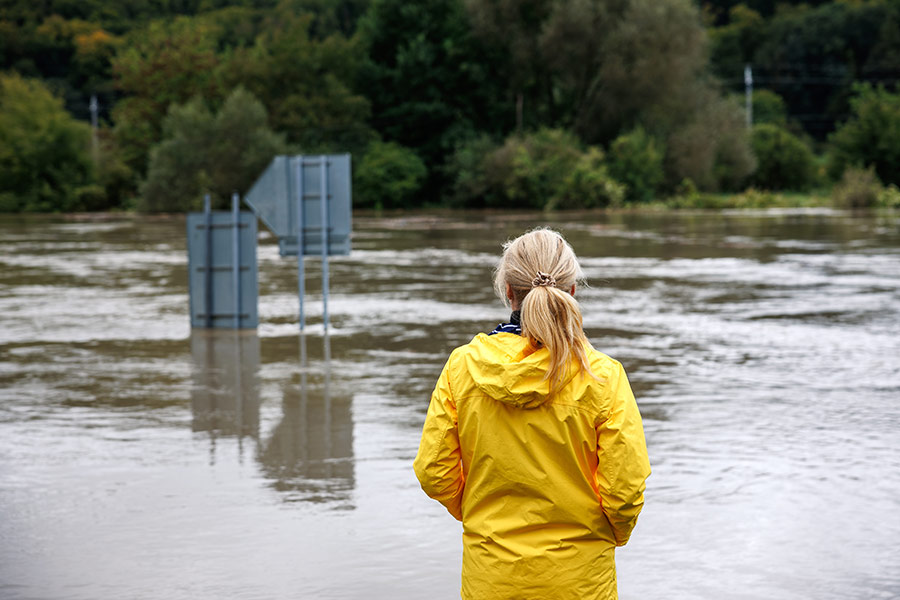Due to their proximity to the Atlantic Ocean and its coastal surges, New York City and the surrounding areas and states can be prone to heavy flooding from excessive rain, storms, snow, overflowing rivers, and more. This year is no exception, with the city repeatedly facing severe flooding that most recently has damaged the subway system, caused a widespread state of emergency, cost many their homes and vehicles, and even cost some their lives. All residents of areas at risk of flooding should be aware of these risks and how best to prepare to get through a flood alive and unscathed.
Some ways that you can reduce your risk of flood damage before severe weather hits include:
● Create a safety plan for yourself and your loved ones, including where to get to higher ground and away from floodwaters, where to meet if you are separated, etc.
○ Plan in advance where you will go if you are instructed to evacuate the area, and be prepared to stay there for an indefinite amount of
● Learn your area’s flood history, whether or not you are in a flood-prone area, which roads near you flood worst/most often, what types of floods you are at risk for, etc. so you can make preparations
● Prepare an emergency kit of necessities in case of loss of power, resources, etc., including flashlights/lanterns, emergency flares, maps, blankets and layers of dry clothing, medicine and medical supplies, insect repellent, rain safety gear such as rubber coats/gloves/boots, and enough bottled water/nonperishable food that doesn’t need to be cooked/prepared for your entire household, etc.
○ It is recommended that you have enough supplies to last you at least three (3) days, but plan to be in need for longer
○ Make sure that cell phones, laptops, and all other portable electronic devices are charged/have extra batteries (consider acquiring a NOAA Weather Radio or other battery operated radio to receive current updates about conditions in your area); social media may also be helpful in receiving or sending fast updates as well
○ Pack necessities in advance so you can grab what you need and go if a flood strikes your area without or with very little warning
○ Be sure to pack your important documentation, such as your visa, proof of identity, insurance information, medical records, etc.
○ If you have pets, be sure to pack supplies and make preparations for them to travel with you in advance as well
● If possible, purchase flood insurance or check whether your rental insurance covers flood damage: standards homeowners’ insurance does not include it
○ Be sure to do this well in advance, since many flood insurance plans take 30 days to take effect and insurance companies may not sell policies at all if there is the threat of an imminent flood
● Remember that a flood/flash flood watch means that a flood is possible and you should prepare to act, and a flood/flash flood warning means that a flood is happening in your area or will happen very soon, and immediate action must be taken

During and after a storm and/or flood, you should:
● Never wade, swim, or drive through floodwater (“Turn around, don’t drown!”); even if it looks clean or safe enough to cross, it is almost definitely not. According to the American Red Cross, “just 6 inches (15 centimeters) of fast-moving floodwater can knock you over, and 12 inches (30 centimeters) can carry your vehicle away.”
○ Floodwater can also contain downed power lines, hazardous waste, dead , and other debris and contaminants that can harm, sicken, or kill you
○ Never drink, wash or brush teeth with, or prepare food with floodwater
● If necessary to escape floodwater, get to the highest point you can (even on your roof as a very last resort) so you can signal and/or call for help, but never stay in a closed attic or the rising floodwater can trap and drown you
● Never wait to evacuate (you may want to do so even without official instructions), and if time allows lock your doors and unplug electrical equipment before you leave
● If possible, stay indoors, and in all conditions remain as warm and dry as you can
○ Also if possible, stay out of the subway system, which can be very vulnerable to flooding
● Visit the Disaster Assistance website to find an official shelter near you if you cannot stay in your home
● If your home, vehicle, and/or possessions are damaged or lost, call your insurance company to file a claim as soon as possible. Document all damage as thoroughly as possible and keep all receipts related to repairs, cleanup, temporary housing, etc. as they may be reimbursable through your insurance
○ Always wear proper safety gear when cleaning up your home after a flood recedes; see the U.S. Center for Disease Control and Prevention website for the recommended plan for reentering your flood-damaged home
○ Have a professional examine your home to determine the extent of the damage and whether any contaminants (mold, sewage, etc.) remain that could make you sick
If you have any questions or concerns, contact us anytime at info@gravityintprog.com. Stay safe and healthy!






